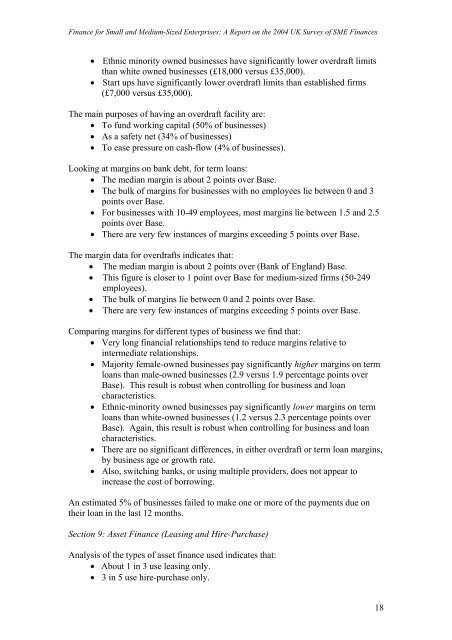Finance for Small and Medium-Sized Enterprises - DTI Home Page
Finance for Small and Medium-Sized Enterprises - DTI Home Page
Finance for Small and Medium-Sized Enterprises - DTI Home Page
Create successful ePaper yourself
Turn your PDF publications into a flip-book with our unique Google optimized e-Paper software.
<strong>Finance</strong> <strong>for</strong> <strong>Small</strong> <strong>and</strong> <strong>Medium</strong>-<strong>Sized</strong> <strong>Enterprises</strong>: A Report on the 2004 UK Survey of SME <strong>Finance</strong>s<br />
• Ethnic minority owned businesses have significantly lower overdraft limits<br />
than white owned businesses (£18,000 versus £35,000).<br />
• Start ups have significantly lower overdraft limits than established firms<br />
(£7,000 versus £35,000).<br />
The main purposes of having an overdraft facility are:<br />
• To fund working capital (50% of businesses)<br />
• As a safety net (34% of businesses)<br />
• To ease pressure on cash-flow (4% of businesses).<br />
Looking at margins on bank debt, <strong>for</strong> term loans:<br />
• The median margin is about 2 points over Base.<br />
• The bulk of margins <strong>for</strong> businesses with no employees lie between 0 <strong>and</strong> 3<br />
points over Base.<br />
• For businesses with 10-49 employees, most margins lie between 1.5 <strong>and</strong> 2.5<br />
points over Base.<br />
• There are very few instances of margins exceeding 5 points over Base.<br />
The margin data <strong>for</strong> overdrafts indicates that:<br />
• The median margin is about 2 points over (Bank of Engl<strong>and</strong>) Base.<br />
• This figure is closer to 1 point over Base <strong>for</strong> medium-sized firms (50-249<br />
employees).<br />
• The bulk of margins lie between 0 <strong>and</strong> 2 points over Base.<br />
• There are very few instances of margins exceeding 5 points over Base.<br />
Comparing margins <strong>for</strong> different types of business we find that:<br />
• Very long financial relationships tend to reduce margins relative to<br />
intermediate relationships.<br />
• Majority female-owned businesses pay significantly higher margins on term<br />
loans than male-owned businesses (2.9 versus 1.9 percentage points over<br />
Base). This result is robust when controlling <strong>for</strong> business <strong>and</strong> loan<br />
characteristics.<br />
• Ethnic-minority owned businesses pay significantly lower margins on term<br />
loans than white-owned businesses (1.2 versus 2.3 percentage points over<br />
Base). Again, this result is robust when controlling <strong>for</strong> business <strong>and</strong> loan<br />
characteristics.<br />
• There are no significant differences, in either overdraft or term loan margins,<br />
by business age or growth rate.<br />
• Also, switching banks, or using multiple providers, does not appear to<br />
increase the cost of borrowing.<br />
An estimated 5% of businesses failed to make one or more of the payments due on<br />
their loan in the last 12 months.<br />
Section 9: Asset <strong>Finance</strong> (Leasing <strong>and</strong> Hire-Purchase)<br />
Analysis of the types of asset finance used indicates that:<br />
• About 1 in 3 use leasing only.<br />
• 3 in 5 use hire-purchase only.<br />
18















![Joint Report on Social Protection and Social Inclusion [2005]](https://img.yumpu.com/19580638/1/190x132/joint-report-on-social-protection-and-social-inclusion-2005.jpg?quality=85)
